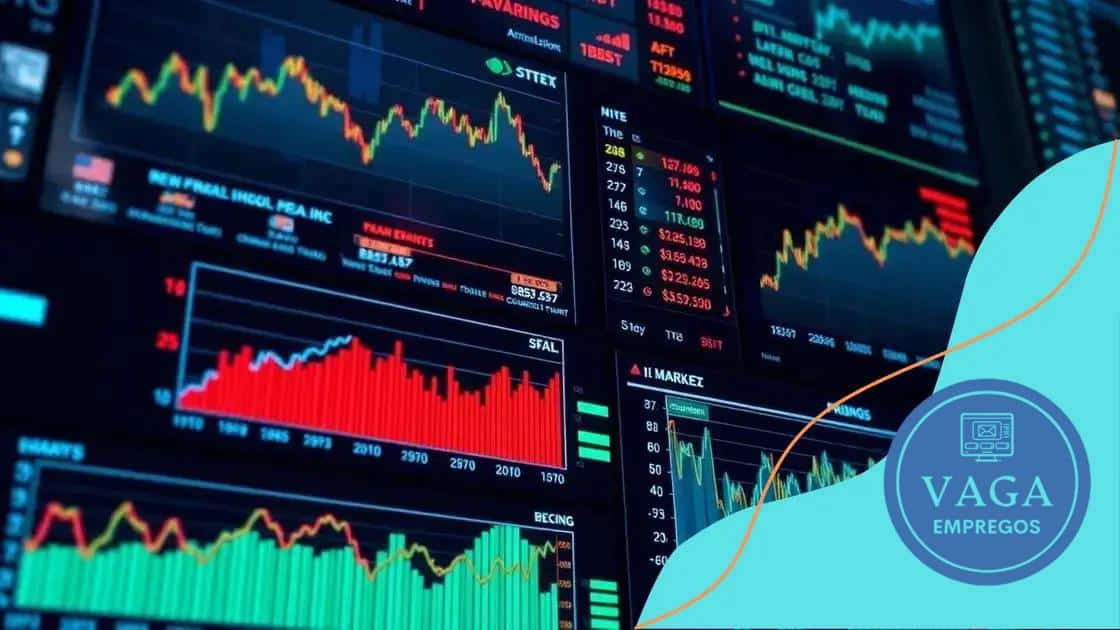Wall Street reacts to mixed economic indicators: what’s next?

Advertisement
Wall Street reacts to mixed economic indicators by creating volatility, compelling investors to utilize strategies like diversification and research to navigate uncertainty effectively.
Wall Street reacts to mixed economic indicators, stirring both concern and opportunity among investors. How do these fluctuations really affect your financial decisions? Let’s dive deeper into the implications and what they mean for your portfolio.
Advertisement
Understanding the current economic landscape
Understanding the current economic landscape is vital for investors. In today’s world, economic indicators play a significant role in shaping market trends. Each indicator provides insights into the overall health of the economy, influencing decisions made on Wall Street.
Advertisement
Gross Domestic Product (GDP) is one of the key indicators. It measures the total value of goods and services produced in a country. A rising GDP suggests a growing economy, while a declining GDP may indicate economic trouble. Investors closely monitor GDP reports to gauge market conditions.
Unemployment Rates
Another important factor is the unemployment rate. It reflects the percentage of the labor force that is unemployed but actively seeking employment. High unemployment can lead to decreased consumer spending, which ultimately affects company profits.
- High unemployment rates often signal economic weakness.
- Low rates typically correlate with a healthy economy.
- Investors analyze these trends to make informed decisions.
Inflation rates also play a crucial role. Inflation reflects how much prices for goods and services rise over time. When inflation is low, purchasing power remains stable, promoting spending and investment. Conversely, high inflation can erode savings and affect market stability.
Consumer Confidence Index
The Consumer Confidence Index (CCI) provides insights into consumer sentiment. When consumers feel optimistic, they are more likely to spend money, driving economic growth. Conversely, a drop in consumer confidence may lead to cautious spending, sparking worries on Wall Street.
Understanding these economic indicators helps investors navigate the complexities of market behavior. For instance, rising interest rates might signal tightening monetary policy, impacting stock prices. Meanwhile, robust earnings reports can rally confidence among investors, driving the market higher.
Staying informed about these factors not only helps in making smart investment choices but also fosters a broader understanding of how the economy functions. In a dynamically changing economic landscape, adaptability and awareness are key for success.
Key indicators impacting Wall Street

Key indicators play a crucial role in shaping the dynamics of Wall Street. Investors need to keep a close eye on these indicators to make informed decisions. Among the most significant are market trends, financial earnings, and economic reports.
Market Trends
Market trends are essential indicators that influence investor sentiment. They can show whether stocks are moving upward or downward over certain periods. A consistent uptrend can attract more investors, while a downtrend may lead to panic selling.
- Understanding the direction of the market helps in strategizing investments.
- Panic selling can sometimes create opportunities for savvy investors.
- Identifying trends early on can yield significant gains.
Another key indicator is financial earnings. Companies report their earnings quarterly, providing insights into their profitability. Strong earnings reports often lead to stock price increases, while disappointing earnings can result in rapid declines.
Economic Reports
Economic reports also significantly impact Wall Street. Reports such as the Consumer Price Index (CPI) and Gross Domestic Product (GDP) provide a snapshot of the economy’s health. For example, if the CPI shows rising inflation, it may prompt the Federal Reserve to raise interest rates.
Interest rates are pivotal for Wall Street as they affect borrowing costs and consumer spending. Higher rates can slow down economic growth, while lower rates typically stimulate investment. Tracking interest rate changes can help investors adjust their strategies accordingly.
Additionally, geopolitical events can alter market performance. Events like elections, trade agreements, or natural disasters influence investor confidence. Staying informed about global happenings is essential for anticipating market shifts.
By understanding these key indicators and their implications, investors can navigate the complexities of Wall Street more effectively. Knowledge about market trends, financial earnings, and economic reports equips investors to make educated decisions in a fast-paced environment.
Market reactions to mixed reports
Market reactions to mixed reports can create uncertainty among investors. When earnings or economic reports are released, they often contain a mix of good and bad news. This imbalance can lead to volatility in stock prices.
Understanding Investor Behavior
Investors tend to react quickly to new information. If a company’s earnings report shows strong revenue but weak future guidance, stocks may drop despite good current performance. Investor psychology plays a crucial role during these times.
- Overreacting to unfavorable news can cause a stock to fall.
- Some investors may see drops as buying opportunities.
- A balanced view helps in making sound decisions during volatility.
Furthermore, mixed economic indicators can complicate market responses. For example, if unemployment rises while consumer spending increases, the overall outlook might appear shaky. Investors often analyze the broader context to assess risks and opportunities.
Market Volatility
Volatility is not unusual during times of uncertainty. Rapid price swings can reflect mixed signals from reports, triggering automatic trading systems that amplify the movements. Traders often hedge their positions to protect against losses when they sense instability.
Another aspect to consider is the timing of the reports. If mixed indicators come out just before a major event, such as an interest rate decision, market reactions can be even more pronounced. Investors might hold back on decisions until they have clearer guidance.
Understanding the dynamics of market reactions is essential for navigating investment decisions effectively. Keeping an eye on trends and broader implications helps mitigate risks during these tumultuous times.
Investor strategies during uncertainty

Investor strategies during uncertainty are essential for navigating volatile markets. When economic indicators are mixed, it’s vital for investors to adapt their approach. This adaptability can significantly impact their financial outcomes.
Diversification
Diversification is one of the most effective strategies. By spreading investments across different asset classes, investors can reduce their risk. If one sector suffers losses, gains in another can help cushion the blow.
- Invest in a mixture of stocks, bonds, and alternative assets.
- Consider international markets to further spread risk.
- Adjust portfolios regularly to reflect changes in economic conditions.
Another valuable strategy during uncertain times is to maintain a long-term perspective. Focusing on long-term goals can mitigate the emotional impacts of short-term market fluctuations. Investors should remember that market downturns are often temporary.
Research and Analysis
Conducting thorough research is also crucial. Understanding the fundamentals of investments helps investors make informed decisions. Staying updated on economic reports and company performance offers insights into potential market movements.
Many investors choose to set stop-loss orders to limit potential losses. This strategy involves placing an order to sell an asset when it reaches a certain price, protecting investors from significant downturns.
Additionally, keeping a cash reserve can be beneficial. Having liquidity allows investors to take advantage of opportunities as they arise without having to sell off other investments.
Ultimately, the right mix of strategies can help investors navigate periods of uncertainty more effectively. By employing these methods, they can position themselves for success even when market conditions are challenging.
Potential future trends and forecasts
Potential future trends and forecasts play an important role in shaping investor strategies. Understanding these trends helps investors anticipate market movements and make informed decisions. As the economy evolves, various factors will influence the financial landscape.
Technological Advancements
One significant trend is the rise of technological advancements. Innovations in artificial intelligence, machine learning, and blockchain technology will likely impact various industries. Businesses that adopt these technologies can increase efficiency and drive growth, attracting investor interest.
- Companies utilizing AI for data analysis may outperform competitors.
- Blockchain technology can enhance transparency and security.
- Investors should look for tech-driven businesses on the rise.
Furthermore, sustainable and socially responsible investing (SRI) is gaining momentum. Investors increasingly seek companies committed to environmental, social, and governance (ESG) criteria. This shift reflects changing consumer values and can lead to potential long-term growth.
Global Economic Shifts
Global economic shifts could also shape future trends. Geopolitical events, trade policies, and demographic changes may significantly impact markets. Investors must monitor these elements to understand potential risks and opportunities.
Interest rate changes by central banks will remain a crucial factor. As economies recover, rates may rise to combat inflation. Higher interest rates can affect borrowing costs and consumer spending, which in turn influences market performance.
In addition, the shift towards remote work and digital communication may redefine workplace dynamics. Companies that adapt to these changes could thrive, presenting new opportunities for investors. Staying informed about industry trends and forecasts is essential for long-term success.
FAQ – Frequently Asked Questions About Wall Street and Economic Indicators
What are key economic indicators?
Key economic indicators include metrics like GDP, unemployment rates, and inflation rates that help assess the health of the economy.
How do mixed reports affect investor decisions?
Mixed reports can create uncertainty, prompting investors to carefully analyze the information before making decisions on buying or selling stocks.
What strategies should investors use during uncertain times?
Investors should consider diversification, maintaining a long-term perspective, and conducting thorough research to navigate uncertainty.
Why is it important to understand future trends?
Understanding future trends helps investors identify potential opportunities and risks, allowing them to make more informed investment decisions.





